#valentin de boulogne
Explore tagged Tumblr posts
Text

Valentin de Boulogne, Judith with the Head of Holofernes
758 notes
·
View notes
Text
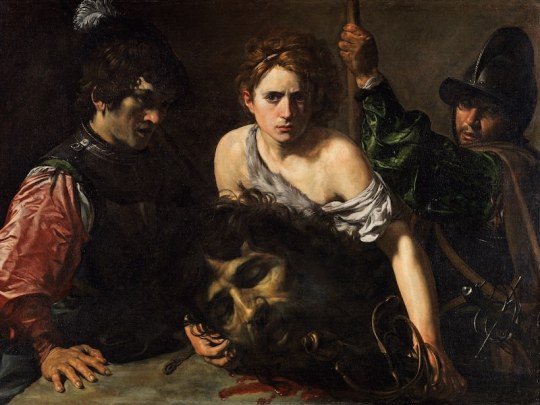
Valentin de Boulogne - David with the Head of Goliath (1615–16)
257 notes
·
View notes
Photo

A Young Shepherd wearing a Crown of Laurel Leaves and holding a Recorder, Attributed to Valentin de Boulogne
717 notes
·
View notes
Text

Valentin de Boulogne
#valentin de boulogne#angel#art#artwork#fine art#fineart#painting#art history#history of art#women in art
81 notes
·
View notes
Text
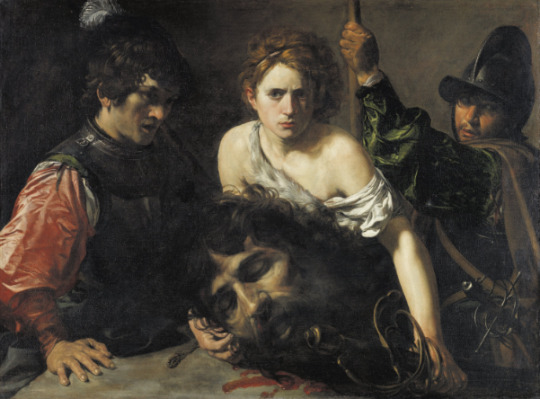
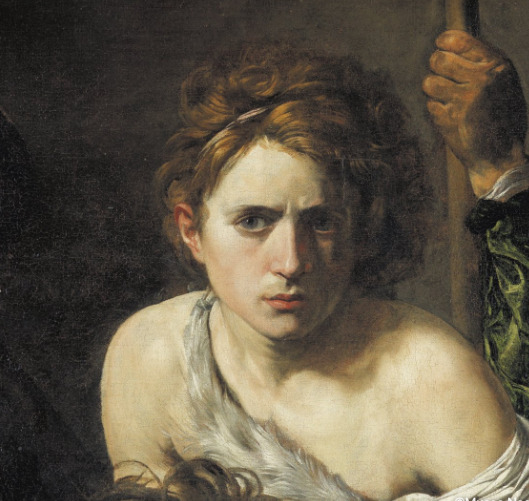

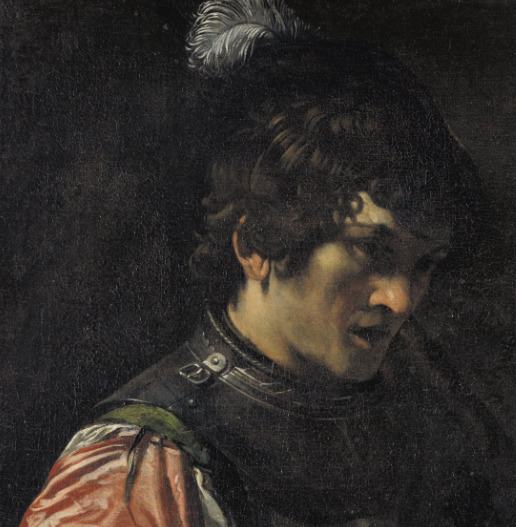
David with Goliath and two soldiers, Valentin de Boulogne, 1620-22
#art history#art#painting#17th century#french art#baroque art#aesthethic#valentin de boulogne#david#goliath#dark academia#david and goliath#museo thyssen bornemisza
362 notes
·
View notes
Text

Judgment of Solomon
Artist: Valentin de Boulogne (French, 1591–1632)
Date: c. 1627–1630
Medium: Oil on canvas
Collection: Louvre Museum, Paris, France
Description
This rethinking of the picture now at the Louvre (on view for exhibition at the MET) has puzzled scholars. At the very least, it testifies to the fame of that work. But the changes also indicate the artist’s growing interest in clarity of exposition through gesture and facial - expression - ideas he shared with his compatriot Nicolas Poussin. The carefully articulated pose and commanding gesture of Solomon are especially telling.
The Judgment of Solomon
The Judgment of Solomon is the biblical example of King Solomon’s wisdom. When Solomon ascended to the throne, he sought after God, and God gave him opportunity to ask for whatever he wanted. Solomon humbly acknowledged his inability to rule well and unselfishly asked God wisdom. God gave him wisdom and wealth besides (1 Kings 3:4–15; 10:27). In fact, “King Solomon was greater in riches and wisdom than all the other kings of the earth” (1 Kings 10:23). God also gave Solomon peace on all sides during most of his reign (1 Kings 4:20–25). The account of the Judgment of Solomon is found in 1 Kings 3:16–27:
Now two prostitutes came to the king and stood before him. One of them said, “Pardon me, my lord. This woman and I live in the same house, and I had a baby while she was there with me. The third day after my child was born, this woman also had a baby. We were alone; there was no one in the house but the two of us.
“During the night this woman’s son died because she lay on him. So she got up in the middle of the night and took my son from my side while I your servant was asleep. She put him by her breast and put her dead son by my breast. The next morning, I got up to nurse my son—and he was dead! But when I looked at him closely in the morning light, I saw that it wasn’t the son I had borne.”
The other woman said, “No! The living one is my son; the dead one is yours.”
But the first one insisted, “No! The dead one is yours; the living one is mine.” And so they argued before the king.
The king said, “This one says, ‘My son is alive and your son is dead,’ while that one says, ‘No! Your son is dead and mine is alive.’”
Then the king said, “Bring me a sword.” So they brought a sword for the king. He then gave an order: “Cut the living child in two and give half to one and half to the other.”
The woman whose son was alive was deeply moved out of love for her son and said to the king, “Please, my lord, give her the living baby! Don’t kill him!”
But the other said, “Neither I nor you shall have him. Cut him in two!”
Then the king gave his ruling: “Give the living baby to the first woman. Do not kill him; she is his mother.”Solomon’s strategy relied on the reality of the maternal instinct. He knew the true mother would prefer losing her son to another woman over seeing him killed. Solomon’s shrewdness in getting to the truth and the just verdict he pronounced caused everyone to take note: “When all Israel heard the verdict the king had given, they held the king in awe, because they saw that he had wisdom from God to administer justice” (1 Kings 3:28).
#painting#christianity#king solomon#king solomon's wisdom#book of 1 kings#christian art#oil on canvas#solomon's court#women#baby#men#bible story#valentin de boulogne#french painter#17th century painting#french art#holy bible#biblical#royal throne
28 notes
·
View notes
Text

Concert Valentin de Boulogne (French; 1591–1632) ca. 1615 Oil on canvas Indianapolis Museum of Art, Indianapolis, Indiana
#Valentin#Valentin de Boulogne#French art#French artists#French painters#French paintings#concerts#musicians#Baroque art#French Baroque#wine#music#love#song#musical instruments#gypsy#gypsies#wine glass#wine glasses#French Baroque art#French Baroque painters#1610s#17th century#17th-century French art#17th-century French artists#17th-century French painters#Caravaggesque#pickpockets#armor#taverns
27 notes
·
View notes
Text

Valentin de Boulogne (1591-1632) "The Fortune Teller" or "Fortune Teller with Soldiers" (c. 1620) Oil on canvas Tenebrism Located in the Toledo Museum of Art, Toledo, Ohio, United States This painting is a play on the cheater being cheated and the corruption of Rome, with the man in the red hat stealing from the fortune teller's while a little girl steals his bag of coins. The cheater being cheated is a reference to deceit, which was a common trait of both men and women during the early 17th century in Rome. It was common to steal things such as the items shown in the painting. Rome was a very dangerous place with drunkards, sword/knife fights, and murder throughout the city.
#paintings#art#artwork#genre painting#fortune telling#valentin de boulogne#oil on canvas#fine art#tenebrism#toledo museum of art#museum#art gallery#french artist#history#art analysis#rome#theft#stealing#thief#thieves#1620s#early 1600s#early 17th century#clothing#clothes
106 notes
·
View notes
Text

Samson, 1630–31.
Valentin de Boulogne - French, 1591–1632
Oil on canvas; 135.6 x 102.8 cm
21 notes
·
View notes
Text
nobody could decide which stories they wanted me to share. they want me to share all of them 😭😭
i’ll start with jesus and john and why i think they’re gay for each other, supported by biblical evidence provided by Seton Catholic Homeschooling of America.
• i took this course in my tenth grade year. i was only homeschooled for 9th and 10th grade. i was public schooled before then, and later went to boarding school for my last two years of hs. but that’s another post.
this is a long post. buckle in. i’ll have it all below the cut
• i no longer have the textbook title, and only have pictures from this text book that i took in a delusional haze when reading this in my catholic mother’s household, hoping that she wouldn’t look through my phones photos to find these images.
this is all from a catholic standpoint, other forms of christianity are not accounted for. if you do not want to see GAY CONTENT ABOUT JESUS, move along
this post is about to unlock so much of my old hyperfixation on the catholic church that i had before leaving.
first of all, as backstory for those who don’t know john:
• john is one of jesus’ twelve disciples and wrote the Gospel of John (I, II, and III) which is a hella important book in the new testament (the second half of the bible.)
• the books of john tell the story of jesus’ life from birth to death. now, that’s kinda gay to write about another man that much, hmm.
• john has also earned the affectionate title of: “The Beloved Disciple”
• he is also traditionally credited with writing Revelations (also known as Apocalypse, which tells how the world is gonna end. fun right!!), though scholars are unsure if he wrote it, or a different john wrote it.
okay, now onto the gay stuff:
• most people jokingly ship judas and jesus because of the angst of judas’ betrayal to jesus. however, i disagree.
• though, knowing their ages, shipping jesus and john would be quite problematic these days, it was quite an acceptable age gap back then. jesus was around the ages of 30-33 at the time of his death, and john was a young adult, about 18. (yikes)
• my evidence begins with the way john writes about himself and jesus in the Gospel of John. in his gospel, he never calls himself john. you guys know what he calls himself in his gospel?? “the discipline whom jesus loved”
😐
sir. could you be ANY more obvious??
so far, all of this info is directly from my catholic textbook.

WOW! that page unpacks a lot. let me elaborate on the way john leaned up on jesus’ chest. first of all, that’s a real bible quote. let’s go:
John 13:23-25
• “23 One of his disciples, the one Jesus loved, was at the table to the right of Jesus in a place of honor. 24 So Simon Peter gestured to this disciple to ask Jesus who it was he was referring to. 25 Then the disciple whom Jesus loved leaned back against Jesus’ chest”
the passage then goes on to john (the disciple whom jesus loved) asking jesus who’s gonna betray him.
• to FURTHER add to this gay af moment, there are PAINTINGS of it, completed by MULTIPLE artists. i’m going to provide the image in my textbook, and then images found online that i particularly enjoy.
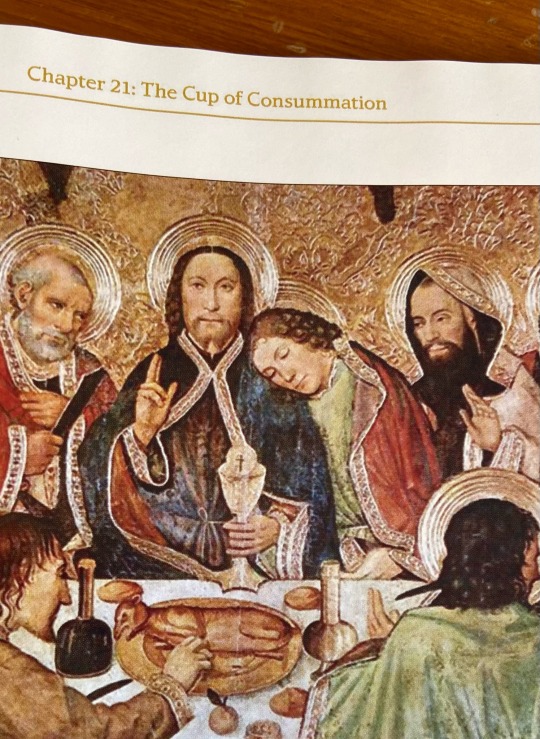
above: lovely image! i cannot remember the artist for the life of me.

above: Jesus and John at the Last Supper by Valentin de Boulonge
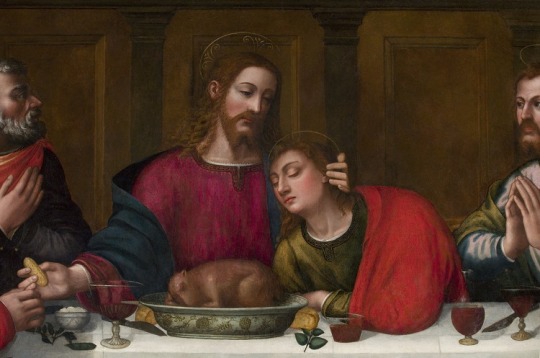
above: Last Supper by Plautilla Nelli (portions of the image were cropped)

above: cannot find artist’s name.
• if you are interested in finding hundreds more of images like this, all you need to type into google is “john leaning on jesus”. you’ll get the images you need. trust me
• those were my largest pieces of evidence, but there are smaller ones i’d like to share. the textbook helped “gay it up”. i think the author of this textbook was a closeted homosexual. cause no way did a straight person write this thinking “hmmm that’s totally platonic and not at all queer, cause that’s how i feel about MY best friend.”
here’s direct textbook images:
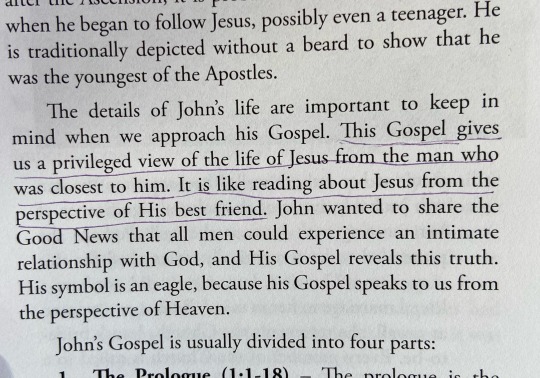
• hmmm man who was closest to him you say???
• “intimate relationship with God”
• best friend? 🤔 are we sure about that?
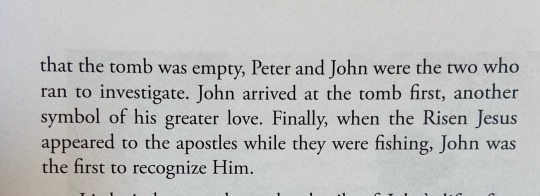
• symbol of his greater love?
• AND he was the first to recognize jesus??
• y’all. they’ve got to be shitting me atp. no way were they not In Love
and finally, from my study questions:
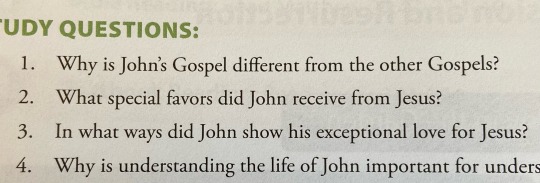
y’all. special favors? exceptional love?
this textbook had me GOBSMACKED. jaw DROPPED. WDYM THAT JESUS AND JOHN WERE DEFINITELY IN LOVE???
conclusion:
• i HIGHLY recommend you looking up more pictures of john laying on jesus.
• i think of john/jesus as canon. there’s too much evidence to support my point. including The Bible. judas/jesus is like what fanfics are for. they’re the pair that everyone wishes happened in canon, but the authors sucked, so it didn’t.
• literally, drop any questions in the reblogs and comments. i’ll be HAPPY to answer.
(and jesus/judas shippers, i hope i changed your mind.)
#jesus x john#jesus x judas#anti catholic#anti christianity#(putting those in so catholics can filter this post out)#last supper#valentin de boulogne#ex christian#ex catholic#anti religion#ex religious#cress talks way too much
40 notes
·
View notes
Photo
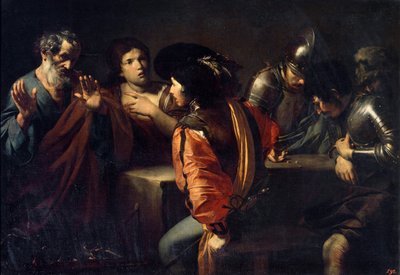
Die Ablehnung des Heiligen Petrus von Valentin de Boulogne (1611, oil painting)
#kunst#kunstwerk#art#artwork#valentin de boulogne#künstler#artist#religion#religiöse kunst#religious art#heiliger petrus#petrus#saint peter#peter#heilig#holy#apostel#apostle#jesus#christ#christus#jesus christ#ablehnung#denial#bibel#bible#glaube#faith#beten#pray
18 notes
·
View notes
Text

Valentin de Boulogne, The Judgement of Solomon
22 notes
·
View notes
Text

Valentin de Boulogne - Samson (1631)
87 notes
·
View notes
Text
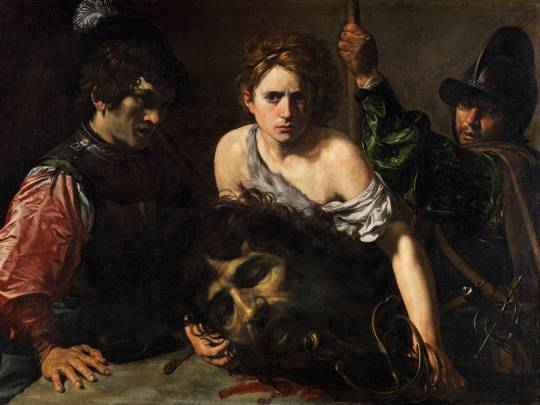
David with the Head of Goliath and Two Soldiers (Valentin de Boulogne, 1620-22)
26 notes
·
View notes
Text

Valentin de Boulogne
33 notes
·
View notes
Text




Saint Gerome, Valentin de Boulogne, 1618-22
#saint gerome#valentin de boulogne#galleria sabauda#17th century#baroque#art history#art#aesthethic#painting
63 notes
·
View notes